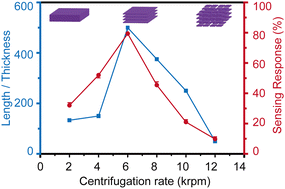Gas sensing properties have long been associated with material dimensions. However, for sensing films consisting of two-dimensional transition metal dichalcogenide nanosheets, despite tremendous progress, the study of nanosheet size has not led to a clear path in optimal gas sensing performance. Herein, we present a technique for optimizing room temperature gas sensing via the control of nanosheet aspect ratio, i.e. tuning both the lateral dimension and thickness of nanosheets simultaneously. Through elucidating clearly the tradeoff between the quantity of active gas sensing sites and interface resistances as nanosheet size changes, systematic design is thus possible. As a demonstration, a room temperature formaldehyde gas sensor has been fabricated using aspect-ratio-controlled TaS2 few-layer nanosheets, synthesized by a custom centrifugation-assisted liquid-phase exfoliation method. The sensor based on the TaS2 nanosheets with optimal aspect ratio enables an ultra-large room temperature response of 78% toward 10 ppm formaldehyde, the highest reported thus far. This work illuminates the potential of aspect ratio control as a primary design parameter towards systematic optimization of nanosheet-based semiconductor functional devices.
